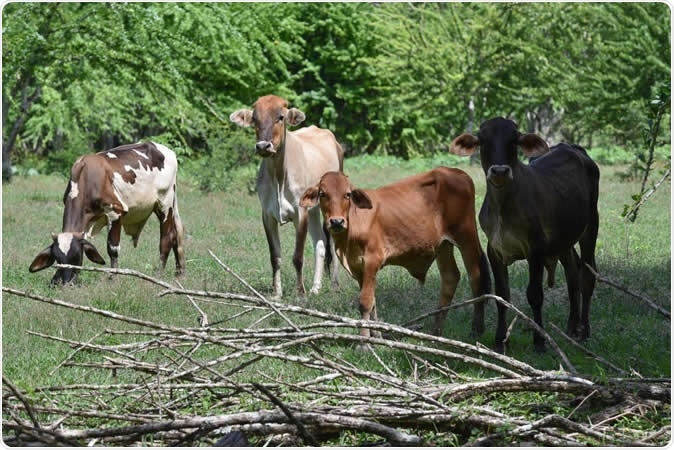
To prevent global warming the whole food system must change
Unless we are willing to change the way we look at food and farming, climate change strategies will fail, says a new report from the CGIAR Research Program on Climate Change, Agriculture and Food Security (CCAFS). The report titled, 'Food and Earth Systems: Priorities for Climate Change Adaptation and Mitigation for Agriculture and Food Systems' is published in the MDPI journal Sustainability,

Traditional livestock system in Colombia. Image Credit: Neil Palmer / CIAT
Global climate change, or global warming, has long been a threat driving innumerable national and international discussions on policy change. However, farming and the food system have been consistently left out of such discussions, chiefly because of other issues. These include questions like mandatory commitments to agricultural changes which could hit small farmers, limitations on farmland expansion, technological challenges in carbon monitoring by small farmers, and trade restriction in high-emission agricultural areas which could affect export-oriented farmers severely.
The greatest resistance to climate change action comes when it comes to changing the food system, says the CCAFS analysis.
CCAFS leader Ana Maria Loboguerrero sums it up: “If you think about the two-degree increase, efforts need to go beyond the agricultural sector. This means reducing emissions by stopping deforestation, decreasing food loss and waste, reducing supply chain emissions, and rethinking human diets, if we really want to get on track to that target. “
Food wastage
One way is to cut down on food waste.
Agriculture, along with forestry and land use, causes one-fourth of greenhouse gas (GHG) emissions. About half of this (10-12%) is due to farming alone. On the other hand, as much as one-third of the food produced on farms is wasted, causing another 8% of emissions.
In developing nations, most of the waste occurs during food production, but in industrialized regions, much more is lost during consumption.
Saving just a quarter of this wastage would feed 870 million people a year – more than the estimated 820 million people who are malnourished at present. Just as importantly, this would reduce agricultural emissions and benefit small farmers, who typically suffer the most from climate change.
Farmers are slow to pick up low-emission practices. The 2030 target for emissions reduction is 1 gigaton (GT), which is 1% of current annual global emissions. Current agricultural changes can contribute only 20% to 40% of this, at most.
Shift eating patterns
A second way is to change the way we eat.
In 2000, meat and dairy farming produced about 18% of GHG emission caused by humans, including deforestation and land-use practices. It may rise to 25% by 2050, as the population and meat consumption rates increase.
Meat substitutes, and low-emission cattle, are some possible solutions being worked out to help reach this goal. However, thinking through traditional diets and making changes is important in mitigating climate change.
Prevent deforestation by intensified agriculture
A third measure is to help farmers use their land better. This should be done while preserving soil fertility, and if applied in just 20 tropical countries, could cut emissions by 1.3 GT per year.
The current review of 160 papers on food systems and farming across the world focuses on food supply chains and small/family farms in developing countries. These use about 87% of the world’s farmland, to feed 2.5 billion people. They produce 3% to 4% of global emissions (a third of agriculture emissions), but will be hardest hit in case of climate change.
Measures to help smallholders adapt and survive include:
- better and more wide-based technological access to relevant climate and market data
- crop insurance to promote resilience and overcome productivity and marketing risks
- social safety coverage against extreme climate events that threaten their livelihood
- access and training in climate-smart agriculture to increase productivity, adapt to climate change, and lower emissions
Plan for inevitable migration
Forced migration is already inevitable for hundreds of millions of farmers and their families due to the forces already set in action, such as desertification, a rise in sea level, and loss of soil fertility. For these people, policymakers should plan how they can mitigate their distress and help them live better in their new neighborhoods.
Summary
Most people would rather learn how to cope with climate change, rather than mitigate it by reducing GHG emissions in agriculture. Farmers may resent not being free to farm as they want, and it may cost more. This will, undoubtedly, be a costly exercise for agrarian economies.
However, it will be much more expensive to cope with climate change in the long term, while mitigation can prevent much of that expense. The knack will be to introduce adaptation strategies which also mitigate climate change, and move on from there to discuss mitigation proper.
Source:
Loboguerrero, A. M. et al., (2019). Food and earth systems: priorities for climate change adaptation and mitigation for agriculture and food systems. Sustainability. https://doi.org/10.3390/su11051372

No comments:
Post a Comment